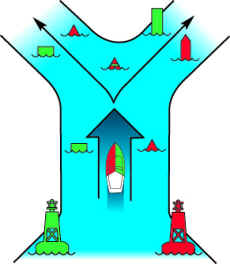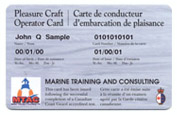Special Buoys |
Special Buoys
Description: Shapes have no significance
May be lettered - No numbers
Cautionary, scientific and anchorage buoys may display a yellow 'X' topmark
Yellow lights - Flash characteristics (if equipped)
Retroreflective material of the same colour as required markings. White buoys will display yellow material.
|
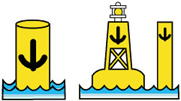 |
Anchorage Buoy
An anchorage buoy marks the perimeter of designated anchorage areas; consult a chart for water depth.
|
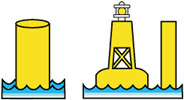 |
Cautionary Buoy
A cautionary buoy marks dangers such as firing ranges, underwater pipelines, race courses, seaplane bases and areas where no through channel exists.
|
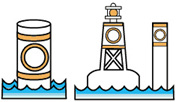 |
Control Buoy
A control buoy indicates speed limits, wash restrictions, etc.; obey the restrictions illustrated within the orange circle.
|
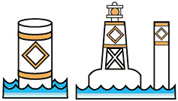 |
Hazard Buoy
A hazard buoy marks random hazards such as shoals and rocks. Information concerning the hazard is illustrated within the orange diamond.
|
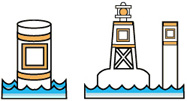 |
Information Buoy
An information buoy displays information such as locality, marina, campsite, etc.; Be guided by the information illustrated within the orange square.
|
 |
Keep-Out Buoy
A keep out buoy marks areas in which boats are prohibited.
|
 |
Mooring Buoy
A mooring buoy is used for mooring or securing vessels; be aware that a vessel may be secured to such a buoy (but never to a navigational buoy).
|
 |
Scientific (ODAS) Buoy
An Ocean Data Acquisition System buoy collects meteorological and other scientific data.
|
 |
Swimming Buoy
A swimming buoy marks the perimeter of swimming areas. May not be charted.
|
 |
Port Hand Daybeacon
When proceeding upstream, keep this beacon on the vessel's port (left) side.
|
 |
Starboard Hand Daybeacon
When proceeding upstream, keep this beacon on the vessel's starboard (right) side.
|
 |
Junction (preferred channel to the right)
Marks a point where the channel divides and may be passed on either side. If the preferred channel is desired, beacon should be kept on the vessel's port (left) side.
|
 |
Junction (preferred channel to the left)
Marks a point where the channel divides and may be passed on either side. If the preferred channel is desired, beacon should be kept on the vessel's starboard (right) side.
|
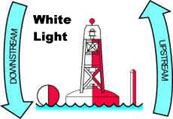 |
Fairway Buoy
This buoy indicates safe water. Used to mark land-falls, channel entrances or channel centres. It may be passed on either side but should be kept to the port (left) side when proceeding in either direction.
|
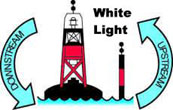 |
Isolated Danger Buoy
An isolated danger buoy is moored on, or above, an isolated danger that has navigable water all around it. Consult the chart for information concerning the danger, (dimensions, depth, etc). May be used to mark natural dangers such as small shoals or obstructions such as wrecks.
|










